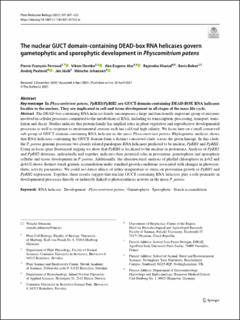| dc.description.abstract | Key message In Physcomitrium patens, PpRH1/PpRH2 are GUCT-domain-containing DEAD-BOX RNA helicases localize to the nucleus. They are implicated in cell and tissue development in all stages of the moss life cycle. Abstract The DEAD-box-containing RNA helicase family encompasses a large and functionally important group of enzymes involved in cellular processes committed to the metabolism of RNA, including its transcription, processing, transport, trans lation and decay. Studies indicate this protein family has implied roles in plant vegetative and reproductive developmental processes as well as response to environmental stresses such has cold and high salinity. We focus here on a small conserved sub-group of GUCT domain-containing RNA helicase in the moss Physcomitrium patens. Phylogenetic analysis shows that RNA helicases containing the GUCT domain form a distinct conserved clade across the green lineage. In this clade, the P. patens genome possesses two closely related paralogues RNA helicases predicted to be nuclear, PpRH1 and PpRH2. Using in-locus gene fuorescent tagging we show that PpRH1 is localized to the nucleus in protonema. Analysis of PpRH1 and PpRH2 deletions, individually and together, indicates their potential roles in protonema, gametophore and sporophyte cellular and tissue development in P. patens. Additionally, the ultrastructural analysis of phyllid chloroplasts in Δrh2 and Δrh1/2 shows distinct starch granule accumulation under standard growth conditions associated with changes in photosyn thetic activity parameters. We could not detect efects of either temperature or stress on protonema growth or PpRH1 and PpRH2 expression. Together, these results suggest that nuclear GUCT-containing RNA helicases play a role primarily in developmental processes directly or indirectly linked to photosynthesis activity in the moss P. patens. | en_US |

